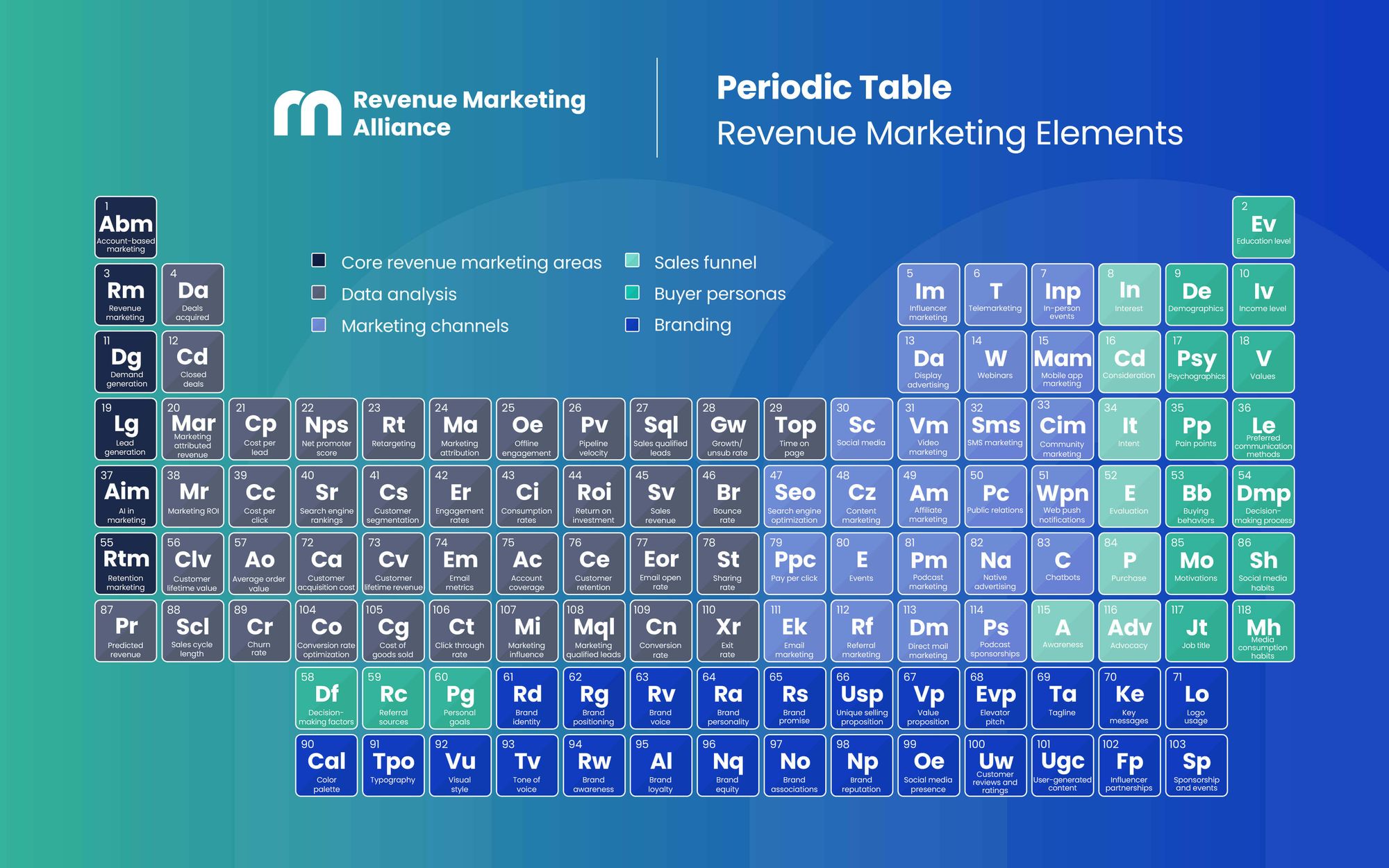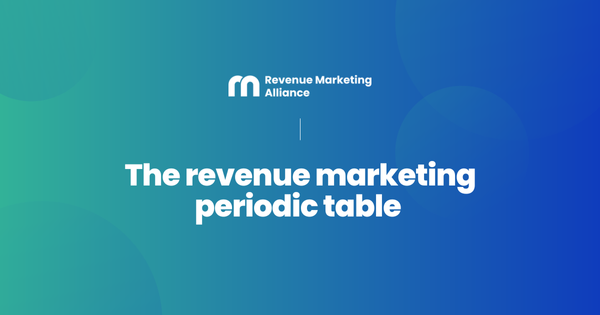Are you looking to improve your revenue marketing efforts? If so, you're not alone. Many businesses are constantly striving to improve their marketing campaigns in order to drive more revenue and growth. But with so many different elements involved in revenue marketing, it can be difficult to know where to start.
That's where the revenue marketing periodic table comes in. This innovative infographic includes all the crucial elements needed for successful revenue marketing, including core revenue marketing areas, data analysis, marketing channels, the sales funnel, buyer personas, and branding.
By using the periodic table as a guide, businesses can streamline their marketing efforts and achieve better results.
In this article, we'll explore:
- The importance of revenue marketing
- The periodic table and how it can help businesses achieve their marketing goals
- How to use the revenue marketing periodic table effectively
So if you're ready to take your revenue marketing efforts to the next level, keep reading!
Why revenue marketing is essential
We won’t go into the finer details of what revenue marketing is and why it’s so important. We’ve got a guide for that, which you can read at your leisure.
What we will say, is that our State of Revenue Marketing 2023 report showed that 47.1% of marketers said they lack the resources to effectively drive revenue at their organization, despite 70.6% saying that generating marketing-attributed revenue is a top objective.
The fact that over two-thirds of the survey respondents reported the importance of generating marketing-attributed revenue suggests that revenue marketing is becoming increasingly important for businesses.
By establishing a dedicated revenue marketing function, companies can better measure and optimize their marketing efforts to drive revenue growth and improve overall business performance.
The growing interest in revenue marketing also indicates a shift in the way businesses approach marketing. Traditionally, marketing has been viewed as a cost center, with a focus on brand awareness and lead generation.
However, with the rise of digital marketing and the ability to track and measure marketing activities more effectively, businesses are starting to recognize the potential for marketing to drive revenue and contribute directly to the bottom line.
This underscores the need for organizations to prioritize revenue-generating marketing activities to remain competitive and achieve sustainable growth. But how can they do this effectively? Well…
Introducing the revenue marketing periodic table

Just as the periodic table is a fundamental tool in the field of chemistry, the revenue marketing periodic table is a fundamental tool in the field of marketing and achieving revenue growth.
It’s a visual representation of the various components that contribute to a successful revenue marketing strategy. You can use this as a framework to help you understand the different elements that make up an effective revenue marketing program and how they fit together.
Like the periodic table, the revenue marketing periodic table is divided into sections, with each section representing a different category. These are:
- Core revenue marketing areas
- Data analysis
- Marketing channels
- The sales funnel
- Buyer personas
- Branding
Within each category, there are specific tactics, strategies, methods, key performance indicators (KPIs), and so on, you can use to your advantage as a revenue marketer.
Let’s take a closer look at how it’s broken down, shall we?
Core revenue marketing areas
There are six core areas we focus on at Revenue Marketing Alliance based on research of the most searched and successful topics. These are:
- Abm - Account-based marketing
- Rm - Revenue marketing
- Dg - Demand generation
- Lg - Lead generation
- Aim - AI in marketing
- Rtm - Retention marketing
These are key aspects of the revenue generation process, from attracting potential customers to retaining them over the long term.
Account-based marketing
Account-based marketing is focused on targeting high-value accounts and tailoring marketing efforts to their specific needs and preferences.
By understanding the key decision-makers and influences within these accounts, you can create highly targeted marketing campaigns that are more likely to result in conversions.
Revenue marketing
Now why wouldn’t this be a part of the table?! Revenue marketing focuses on driving revenue growth across the customer journey. By taking a data-driven approach to marketing, you can optimize your efforts for maximum impact.
Download the State of Revenue Marketing report to uncover the hidden secrets behind explosive revenue growth and harness the transformative power of your marketing efforts. 🔥
Demand generation
Demand gen is the process of attracting and engaging potential customers through various marketing channels, such as content marketing, email marketing, social media, and advertising.
By creating compelling campaigns that address the needs and pain points of their target audience, you can generate demand for your products or services.
Lead generation
Lead gen involves identifying and engaging potential customers who’ve expressed interest in your product or service.
By creating targeted campaigns that capture the attention of these leads and encourage them to take action, you can generate a steady stream of new business opportunities for your organization.
AI in marketing
Artificial intelligence is increasingly being used in marketing to automate processes, analyze data, and personalize marketing campaigns at scale. By understanding how AI can be used to optimize marketing efforts, you can stay ahead of the curve and drive better results for your business.
Retention marketing
Retention marketing involves engaging and retaining existing customers by providing exceptional customer service, personalized experiences, and ongoing value.
By focusing on retention, you can reduce customer churn and increase customer lifetime value, which can have a significant impact on the bottom line.
Data analysis
Data analysis is another core part of revenue marketing - so much so, it needed a category of its own for the periodic table. It can be used to provide invaluable outlooks into customer behavior which can then be used to inform marketing strategies and drive overall revenue growth.
Using data analysis as a revenue marketer is also beneficial for identifying trends and patterns, measuring return on investment (ROI), personalizing marketing campaigns, and improving the overall customer experience.
Below is a list of all the different elements of data analysis. Choose which metrics are most important for you to measure based on the outcome you’re looking for, and go from there.
Expand for data analysis elements
- Pr - Predicted revenue
- Da - Deals acquired
- Cd - Closed deals
- Mar - Marketing attributed revenue
- Mr - Marketing ROI
- Clv - Customer lifetime value
- Scl - Sales cycle length
- Cp - Cost per lead
- Cc - Cost per click
- Ao - Average order value
- Cr - Churn rate
- Nps - Net promoter score
- Sr - Search engine rankings
- Ca - Customer acquisition cost
- Co - Conversion rate optimization
- Rt - Retargeting
- Cs - Customer segmentation
- Cv - Customer lifetime revenue
- Cg - Cost of goods sold
- Ma - Marketing attribution
- Er - Engagement rates
- Em - Email metrics
- Ct - Click through rate
- Oe - Offline engagement
- Ci - Consumption rates
- Ac - Account coverage
- Mi - Marketing influence
- Pv - Pipeline velocity
- Roi - Return on investment
- Ce - Customer retention
- Mql - Marketing qualified leads
- Sql - Sales qualified leads
- Sv - Sales revenue
- Eor - Email open rate
- Cn - Conversion rate
- Gw - Growth/unsub rate
- Br - Bounce rate
- St - Sharing rate
- Xr - Exit rate
- Top - Time on page
Marketing channels
Utilizing different marketing channels within your revenue marketing strategy is crucial because they provide a means of reaching your potential customers, then aiding in driving revenue growth.
There are a multitude of different channels you can use to your benefit, which’ll help you reach the audience you want. Plus, with different marketing channels, you can expand your targeting capabilities by focusing your efforts on specific segments which’ll increase engagement and conversions.
You’ll also be able to diversify your marketing efforts and mitigate the risk of change in customer behavior or shifts in the marketing landscape due to constantly changing trends.
Below are the different types of marketing channels you can focus your efforts on to optimize your campaigns for maximum impact.
Expand for marketing channel elements
- Seo - Search engine optimization
- Ppc - Pay per click
- Ek - Email marketing
- Sc - Social media
- Cz - Content marketing
- E - Events
- Rf - Referral marketing
- Im - Influencer marketing
- Da - Display advertising
- Vm - Video marketing
- Am - Affiliate marketing
- Pm - Podcast marketing
- Dm - Direct mail marketing
- T - Telemarketing
- W - Webinars
- Sms - SMS marketing
- Pc - Public relations
- Na - Native advertising
- Ps - Podcast sponsorships
- Inp - In-person events
- Mam - Mobile app marketing
- Cim - Community marketing
- Wpn - Web push notifications
- C - Chatbots
The sales funnel
The sales funnel provides a framework for understanding the customer journey, which is essential to optimizing your marketing efforts and driving revenue growth.
Take a look below at the different stages of the funnel to get a better understanding of where your prospects are in the sales cycle.
Expand for the sales funnel elements
- A - Awareness
- In - Interest
- Cd - Consideration
- It - Intent
- E - Evaluation
- P - Purchase
- Adv - Advocacy

Buyer personas
Buyer personas are important because they provide a clear understanding of who your target audience is, allowing you to develop targeted marketing strategies and campaigns that resonate with them.
They also help to personalize marketing messages and campaigns to their specific needs and create content that connects better to specific segments’ interests. All of this’ll then work to build stronger relationships with your customers over time, increasing the likelihood of engagement, conversions, retention, and then ultimately, overall revenue.
Take a look below at the kind of things you can add to your buyer personas to make sure they’re optimized for maximum impact.
Expand for buyer persona elements
- De - Demographics
- Psy - Psychographics
- Pp - Pain points
- Bb - Buying behaviors
- Mo - Motivations
- Jt - Job title
- Ev - Education level
- Iv - Income level
- V - Values
- Pcm - Preferred communication methods
- Dmp - Decision-making process
- Sh - Social media habits
- Mh - Media consumption habits
- Df - Decision-making factors
- Rc - Referral sources
- Pg - Personal goals
Branding
Branding is incredibly important for any business, but particularly for driving revenue growth. This is because it helps to differentiate your company or product from your competitors, build trust and credibility with your potential customers, and create a strong emotional connection with your target audience.
It’s also essential for maintaining consistency across all of your marketing efforts.
When a company has a strong brand identity that is consistently communicated across channels, it helps to reinforce the core product messaging and value proposition - this makes it much more likely that potential customers will understand and resonate with your brand, then increasing the likelihood of revenue growth.
Below are the elements we’ve included within the table that amalgamate into successful company branding. Have you thought about each of these elements when it comes to your organization’s brand?
Expand for branding elements
- Rd - Brand identity
- Rg - Brand positioning
- Rv - Brand voice
- Ra - Brand personality
- Rs - Brand promise
- Usp - Unique selling proposition
- Vp - Value proposition
- Evp - Elevator pitch
- Ta - Tagline
- Ke - Key messages
- Lo - Logo usage
- Cal - Color palette
- Tpo - Typography
- Vu - Visual style
- Tv - Tone of voice
- Rw - Brand awareness
- Al - Brand loyalty
- Nq - Brand equity
- No - Brand associations
- Np - Brand reputation
- Oe - Social media presence
- Uw - Customer reviews and ratings
- Ugc - User-generated content
- Fp - Influencer partnerships
- Sp - Sponsorship and events
How to use the revenue marketing periodic table
The revenue marketing periodic table has been created as a framework, so you can identify specific tactics and strategies that are most effective at driving revenue growth, and optimizing your marketing efforts.
Specific use cases for the revenue marketing periodic table
There are many different ways you can use the periodic table to your advantage, but let’s just begin with a couple of examples to get you started.
Developing buyer personas that understand your target audience
You can use the table to develop buyer personas that help you better understand your target audience.
By focusing on the "buyer personas" section of the table, you can identify the characteristics, needs, and pain points of your ideal customers, and create targeted marketing campaigns that speak directly to their interests.
For example, you might use data analysis tools to gather information on your target audience, such as their demographics, preferences, and behaviors. Based on this information, you can create detailed buyer personas that help you better understand the specific needs and pain points of your ideal customers.
With this knowledge, you can create marketing campaigns that speak directly to the interests and concerns of your target audience. For instance, you might create blog posts, social media content, and email marketing campaigns that address the specific challenges and pain points of each buyer persona, and provide solutions that address their needs.
Improving brand awareness and reputation
You can use the table to improve your brand awareness and reputation. By focusing on the "branding" section of the table, you can identify the tactics and strategies that are most effective at building a strong brand identity and reputation.
For example, you might focus on tactics like content marketing, social media, and influencer marketing to increase your visibility and reach among your target audience. By using these tactics, you can establish yourself as a thought leader in your industry, build trust with your audience, and ultimately improve your brand reputation.
Download the revenue marketing periodic table
Want the table in poster form? Download the files for free below. If you'd like to share it on any of your socials, we’d appreciate the tag!



 Follow us on LinkedIn
Follow us on LinkedIn



